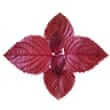Background
- Perilla is a traditional crop of China, India, Japan, Korea, Thailand, and other Asian countries. In North America, it is occasionally called by its Japanese name, shiso. In North America, it is also known as purple mint, Chinese basil, or wild coleus. Perilla seed oil is used for cooking, as a drying oil, and as a fuel. Perilla seed oil is high in the omega-3 fatty acid, alpha-linolenic acid.
- Asian practitioners prescribe perilla for respiratory afflictions and prevention, pregnancy concerns, seafood poisoning, and "incorrect energy balance."
- Some evidence is available for the use of perilla oil for reduction in asthma symptoms, as well as use of perilla extract for seasonal allergies. More clinical evidence is required before recommendations can be made for any clinical usage of perilla.
References
Natural Standard developed the above evidence-based information based on a thorough systematic review of the available scientific articles. For comprehensive information about alternative and complementary therapies on the professional level, go to . Selected references are listed below.
- Baba S, Osakabe N, Natsume M, et al. Absorption, metabolism, degradation and urinary excretion of rosmarinic acid after intake of Perilla frutescens extract in humans. Eur J Nutr 2005;44(1):1-9.
View Abstract - Banno N, Akihisa T, Tokuda H, et al. Triterpene acids from the leaves of Perilla frutescens and their anti-inflammatory and antitumor-promoting effects. Biosci.Biotechnol.Biochem 2004;68(1):85-90.
View Abstract - Gulcin I, Berashvili D, Gepdiremen A. Antiradical and antioxidant activity of total anthocyanins from Perilla pankinensis decne. J Ethnopharmacol 10-3-2005;101(1-3):287-293.
View Abstract - Hamazaki K, Itomura M, Hamazaki T, et al. Effects of cooking plant oils on recurrent aphthous stomatitis: a randomized, placebo-controlled, double-blind trial. Nutrition 2006;22(5):534-538.
View Abstract - Kawai K, Matsuno K, Kasai H. Detection of 4-oxo-2-hexenal, a novel mutagenic product of lipid peroxidation, in human diet and cooking vapor. Mutat.Res 2-28-2006;603(2):186-192.
View Abstract - Kim DS, Kim HR, Woo ER, et al. Inhibitory effects of rosmarinic acid on adriamycin-induced apoptosis in H9c2 cardiac muscle cells by inhibiting reactive oxygen species and the activations of c-Jun N-terminal kinase and extracellular signal-regulated kinase. Biochem Pharmacol 10-1-2005;70(7):1066-1078.
View Abstract - Kim HK, Choi H. Stimulation of acyl-CoA oxidase by alpha-linolenic acid-rich perilla oil lowers plasma triacylglycerol level in rats. Life Sci 8-5-2005;77(12):1293-1306.
View Abstract - Kim JH, Jin YR, Park BS, et al. Luteolin prevents PDGF-BB-induced proliferation of vascular smooth muscle cells by inhibition of PDGF beta-receptor phosphorylation. Biochem Pharmacol 6-15-2005;69(12):1715-1721.
View Abstract - Kim JS, Lee HJ, Lee MH, et al. Luteolin inhibits LPS-stimulated inducible nitric oxide synthase expression in BV-2 microglial cells. Planta Med 2006;72(1):65-68.
View Abstract - Ko WC, Shih CM, Leu IJ, et al. Mechanisms of relaxant action of luteolin in isolated guinea pig trachea. Planta Med 2005;71(5):406-411.
View Abstract - Osakabe N, Yasuda A, Natsume M, Yoshikawa T. Rosmarinic acid inhibits epidermal inflammatory responses: anticarcinogenic effect of Perilla frutescens extract in the murine two-stage skin model. Carcinogenesis 2004;25(4):549-557.
View Abstract - Peng Y, Ye J, Kong J. Determination of phenolic compounds in Perilla frutescens L. by capillary electrophoresis with electrochemical detection. J Agric.Food Chem 10-19-2005;53(21):8141-8147.
View Abstract - Qiao S, Li W, Tsubouchi R, et al. Rosmarinic acid inhibits the formation of reactive oxygen and nitrogen species in RAW264.7 macrophages. Free Radic.Res 2005;39(9):995-1003.
View Abstract - Sanbongi C, Takano H, Osakabe N, et al. Rosmarinic acid in perilla extract inhibits allergic inflammation induced by mite allergen, in a mouse model. Clin Exp Allergy 2004;34(6):971-977.
View Abstract - Takagi S, Goto H, Shimada Y, et al. Vasodilative effect of perillaldehyde on isolated rat aorta. Phytomedicine 2005;12(5):333-337.
View Abstract







